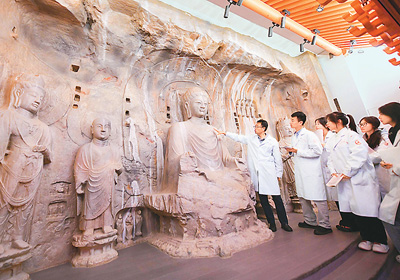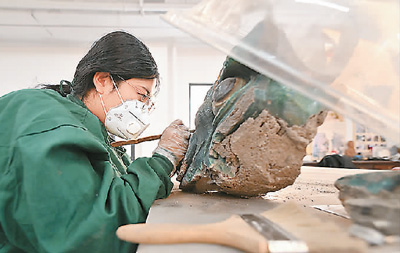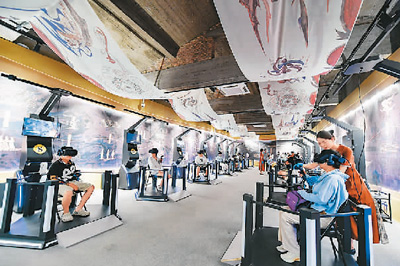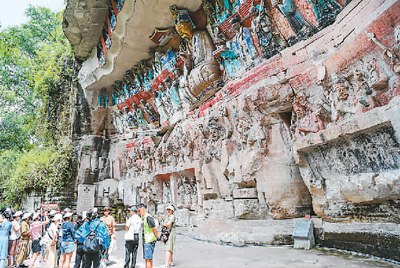China makes remarkable progress in conserving cave temples
China's protection and utilization of cave temples has significantly improved, with growing cultural influence, said Guan Qiang, deputy head of the National Cultural Heritage Administration (NCHA) at the 2024 International Forum on Cave Temple Conservation recently held in Dunhuang city, northwest China's Gansu Province.

Students take classes in the training room for cave temple conservation and restoration techniques at the Conservation and Archaeology of Cultural Relic Department of Luoyang Polytechnic in Luoyang city, central China's Henan Province. [Photo/Zhang Yixi]
Improving protection levels
After over 70 years of efforts, China has eliminated major risks to its key cave temples, which means that the exploration and practice of protecting and restoring cave temples, reinforcing their structure, and improving environmental management, as well as digital preservation and monitoring, have been very effective in the country, Guan added.
Guan noted that China has developed a comprehensive protection strategy for cave temples that includes value interpretation, monitoring and early warning, environmental control, disaster management and restoration.
According to a survey organized by the NCHA, China is home to 2,155 cave temples, and 3,831 cliff sculptures.
From 1950 to 2024, the conservation of China's cave temples has evolved from a preliminary stage of investigation to a stage featuring the in-depth application of scientific and technological innovations, resulting in a concept of cave temple conservation with Chinese characteristics, said Ling Ming, director of the China Academy of Cultural Heritage.

A technician with the Yungang Grottoes Research Institute removes dusts from a piece of relic in Datong city, north China's Shanxi Province. [Xinhua/Zhan Yan]
China has made historical achievements in the conservation of its cave temples, including protecting and reinforcing the structure of the four most famous grottoes, namely, the Mogao Grottoes and the Maiji Mountain Grottoes in Gansu Province, the Yungang Grottoes in north China's Shanxi Province and the Longmen Grottoes in central China's Henan Province. The country has improved environmental management, eliminated major risks, and conducted research on cultural heritage preservation, Ling added.
Shahbaz Khan, director of the UNESCO Regional Office for East Asia, commended China's notable achievements in cave temple and cultural heritage preservation at the forum.
He applauded that the country's digitalization efforts by integrating traditional methods and cutting-edge technologies at sites such as the Mogao Grottoes and the Yungang Grottoes have set a valuable benchmark for global heritage conservation.
Leveraging science and technology
In recent years, there has been rapid development in the research on the mechanisms of damage to cave temples, survey techniques, conservation and reinforcement techniques, and techniques for presentation and utilization, experts said.
China has gradually established a multi-disciplinary joint research model. In the conservation of cave temples, the supporting and guiding role of science and technology has become increasingly prominent.
Su Bomin, dean of Dunhuang Academy, said the academy has established a complete set of key technical systems for the protection of ancient murals and sculptures, reinforcement of cave cliffs and earthen sites, grotto monitoring and early warning, and digitalization of cultural relics by relying on research platforms such as the National Engineering Technology Research Center for the Protection of Ancient Murals and Earthen Sites.
These research results have been implemented at six cave temples under the jurisdiction of the academy and found applications in over 200 cultural heritage conservation projects across 16 provinces, autonomous regions and municipalities, Su said.

Visitors use equipment to visit the Mogao Grottoes at a digital exhibition hall of the grottoes in Dunhuang city, northwest China's Gansu Province. [Xinhua/Lang Bingbing]
Dunhuang Academy has also been making waves in the digitalization of cultural relics, hosting over 30 digital exhibitions both at home and abroad. By leveraging technologies to enhance visitor experiences, the academy has managed to strike a delicate balance between tourism and the conservation of cultural relics, providing reference to the protection and reasonable utilization of cultural heritage.
Liu Hanlong, an academician at the Chinese Academy of Engineering and a professor at Chongqing University in southwest China's Chongqing, and his team have applied microbial mineralization technology for cultural relics. This new technology offers enhanced strength, color consistency and weather resistance compared to traditional restoration materials. It has been successfully applied to several major historical and cultural sites protected at the national level, including the Dazu Rock Carvings in Chongqing.
International cooperation
As an international issue, cave temple protection faces increasing challenges such as climate change, making global cooperation crucial, according to Shahbaz Khan.
Dunhuang Academy, for instance, has been working with the Getty Conservation Institute since the end of the 1980s. In addition, China's cultural heritage protection institutions have had beneficial cooperation on conservation research of cave temples with famous foreign institutions, including Tokyo University of the Arts and the University of Oxford.

Tourists visit the scenic spot of Dazu Rock Carvings in Dazu district, southwest China's Chongqing Municipality. [Xinhua/Wang Quanchao]
The Academy of Dazu Rock Carvings has actively pursued international cooperation on cultural heritage conservation. It has not only engaged in extensive exchanges with Italian cultural heritage conservation institutions, but also launched projects to protect the Shuchengyan Cliff Statues of the Dazu Rock Carvings, laying a solid foundation for the long-term preservation and study of the Dazu Rock Carvings.
Jo Sangsun, a cultural heritage expert in South Korea, paid particular attention to Dunhuang Academy's work on digitalization and weathering issues. He said that China's experience is important not just for South Korea but for the whole world.
China is committed to strengthening international cooperation and contributing to global efforts in cultural heritage conservation and development, said an official from the NCHA.
























